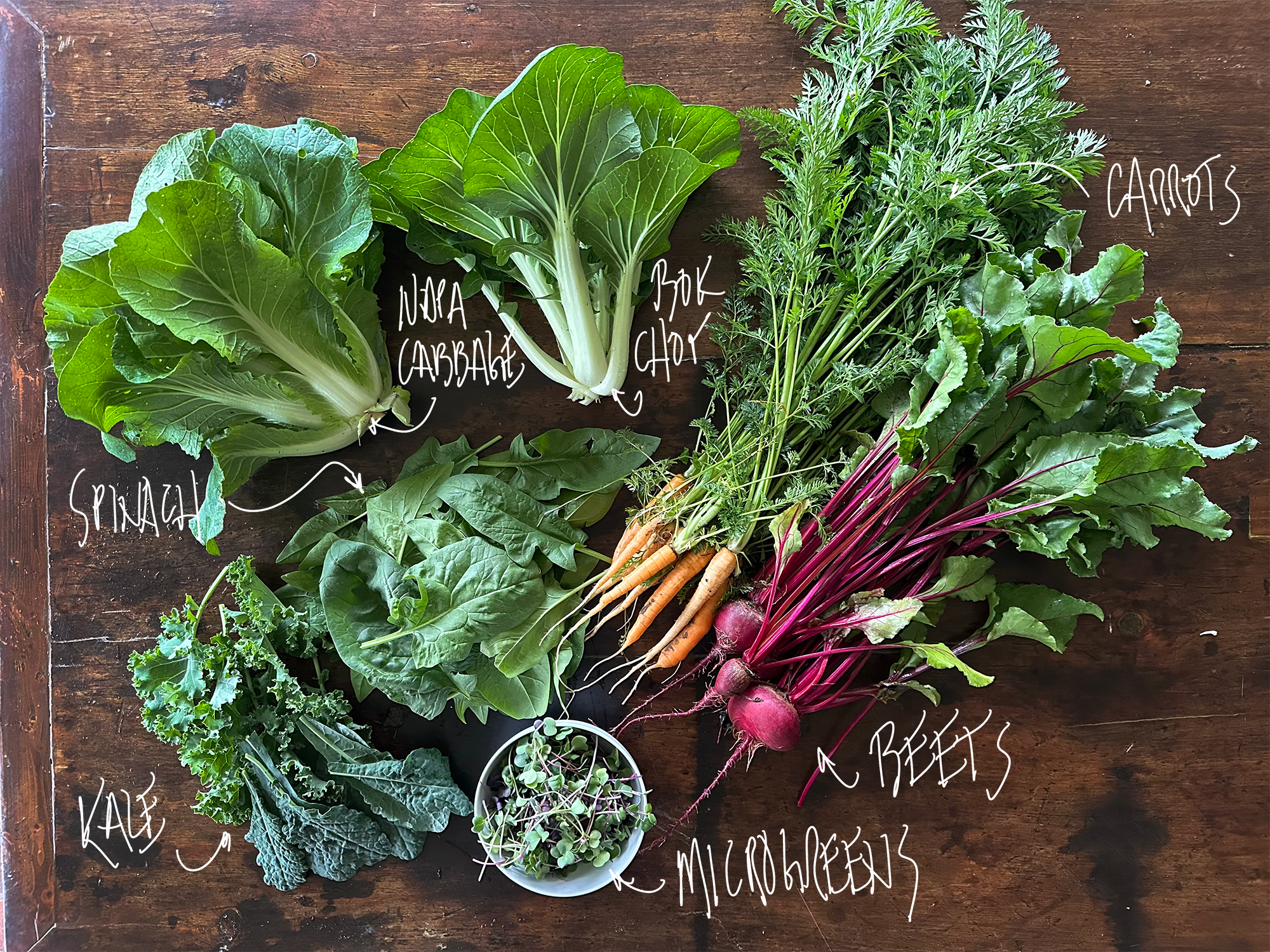2025 Season | Week 1
Welcome to a Fresh 2025
This is our first week of the season - 4 weeks later than last year. We’ve been doling out spinach and microgreens, but this is the first official harvest bounty of the season. The spinach, carrots, and beets have been in the ground since early October. Usually, we’d have carrots almost all winter, but this year, they’ve been slow to materialize. It looks like the first batch may go quickly as the beets start to bolt (meaning the heat has triggered them to go to seed, which makes them bitter, especially the greens). We’ve been walking a fine line with the spinach for a few weeks now, but it’s been pretty tasty so far.
We’ve had a bit of a breakthrough on microgreens. This week, I harvested 2 lbs of perfection. You are missing out if you haven’t included them in your diet. I love cheese, apple, and microgreen sandwiches for lunch. I hope to have more and more this year. They are super-nutritious and flavorful. Microgreens are nutrient-dense, containing higher concentrations of vitamins, minerals, and antioxidants than mature plants. They support immune health, reduce inflammation, and promote heart and digestive wellness. Easy to grow and incorporate into meals, microgreens offer a powerful, natural boost to overall health in a small, flavorful package.
2025 FAQs—Everything You Need to Know
How will we know if there's a pickup each week? We'll let you know if there will be a pickup on Thursday or Friday. We also tell you what veggies are coming your way.
Where will we pick up, and what is the process? Pickups are at the farm - 3584 Sunbury Road - Come down the lane and park by the Yankee Street white refrigerator trailer. The door to the trailer is in the back. Open the lever/doors, take your crate, and check your name off the list and when you picked up. Close the doors securely. Crates will be available after 11:00 am on Saturday mornings. You can come anytime until Monday around lunch to retrieve your crate
What if I am out of town? We encourage you to gift your share to another family member, neighbor, or friend.
Can I take my crate home? You can use our crate to take your vegetables home, bring your bag, and transfer your items. If you take your crate, return your empty one next week so we can swap it with a new one.
How will you communicate with us? I will use texting, but most of our communications will be on the website. We will provide a link to The Bounty - our weekly newsletter on what is in your crate, how to care for it, recipe ideas, and much more. We spend a lot of effort to help you learn and enjoy your fresh produce. See the What's in your Crate section below.
Can We Tour the Farm? Yes, we'll have an Open House in June. Information to follow.
Are you taking any more members? No, our membership is full for the 2025 Season.
How can I buy more? We plan to hold POP-UP sales when we have extra items to sell. More info will follow as well.
Please take a minute and add our contact information card to your email list so our communications are not blocked or filtered.
Here’s what’s in your crate this week.
-
BOK CHOY 101 - As far as cabbage goes, bok choy stands apart. With a crunchy, celery-like texture when cooking times are short, to a unique, creamy texture when left in the pan a little longer. You can steam, stir fry, broil, sauté or eat it raw by mixing it in a salad or slaw (so good it makes us rhyme!). Check out our blog for one of our favorite bok choy recipes!
EAT NOW - Wash bok choy by swishing in a bowl of water to remove dirt between stalks. Baby bok choy can be cooked whole or by halving. For larger varieties, separate leaves from stalk to prevent overcooking.
EAT LATER - Store unwashed bok choy in a perforated plastic bag in the refrigerator for up to 3-5 days. To freeze, blanch, then remove excess water and store them in an airtight bag. Good for up to 10 mo.
To blanch, bring a pot of lightly salted water to a rolling boil. While you wait for boil, prepare an ice bath. Once boiling, drop veggies into water - water should return to boil within a minute otherwise you have too much veg for the water. Once boil has returned, cook for 1-5 min until veg has a vibrant color. Immediately put into ice bath to stop cooking.
RECIPES
-
BEETS 101—Beets are healthy, versatile, taste amazing, and look beautiful. One of the best things about them is that they keep well before and after cooking, and every part is edible and delicious. Beets can be broiled, steamed, grilled, or roasted, our favorite. (We like cut beets roasted in olive oil and salt and pepper the best!)
EAT NOW—Roots: Just before cooking, scrub the beets well and remove any scraggly leaves and rootlets. If your recipe calls for raw beets, peel them with a knife or a veggie peeler, then grate or cut them according to the recipe. To remove the skins, roast them in foil or boil them, and the peels will slip right off.
Beet greens: Wash the leaves in a basin of lukewarm water to remove grit. Remove the thicker stems. Depending on use, cut the greens into appropriately sized pieces.
OR LATER - To Freeze: Beet Roots: Boil or bake beets until done. Cool them in ice water or let them come to room temperature. Remove peels. Trim the beets into 1/4-inch slices or keep them whole (if they are small). Place in a freezer bag and remove as much air as possible. Seal and freeze. Beet greens: Blanch wash beet greens for 2-3 minutes in hot boiling water. Immediately dunk in ice water to stop the cooking process. Then drain and pack into airtight containers. Freeze them in “balls” on a cookie sheet, then pop them into a freezer bag for the perfect portion.
DON’T TOSS THOSE BEET GREENS! - Beet greens are delicious! Here are some simple ways to use them: Use them for making vegetable stock, toss them into a salad — especially the smaller leaves, braised with a bit of olive oil, garlic, and pepper flakes, toss in a smoothie, add them to an omelet, frittata, or quiche, stir them into a pasta sauce in the final stages, add to a soup, like you would kale or spinach, turn them into a pesto
RECIPES
-
CARROTS 101 - Crunchy, tasty, and highly nutritious, carrots are one of our favorite root vegetables. Carrots are a great source of beta carotene, fiber, vitamin K1, potassium, and antioxidants! We’re used to seeing orange carrots, but did you know carrots come in a variety of colors like yellow, white, red, and even purple? Both the root and the greens are edible - the leaves make for a great garnish or addition to pesto. The greens have a slightly bitter taste that compliments the sweetness of the root.
EAT NOW - Because we don’t use pesticides, our carrots don’t need to be peeled. Simply rinse and scrub any dirt before use. Eaten raw, carrots are great whole, julienned, speared, or chopped. Carrots can be boiled, sautéd, stir fried, or even air fried! Fresh carrot tops can be chopped into a green salad or stir-fry too! The greens can also be dried and used as an herb like parsley.
OR LATER - To avoid “floppy carrots,” remove the green tops as soon as you can, leaving about an inch of stems. Save the greens separately. Then, place root in a bag in the fridge or in a bin of water (like celery) to keep them crisp, changing out the water every few days. Uncut carrots will last in the fridge for up to 4 weeks. They can also be chopped, then blanched and placed in an airtight container in the freezer to keep longer. Store the tops in a separate bag in the fridge. Or put them in a plastic Ziplock in your freezer and use them to make DIY vegetable or chicken stock.
To blanch, bring a pot of lightly salted water to a rolling boil. While you wait for boil, prepare an ice bath. Once boiling, drop veggies into water - water should return to boil within a minute otherwise you have too much veg for the water. Once boil has returned, cook for 1-5 min until veg has a vibrant color. Immediately put into ice bath to stop cooking.
RECIPIES
-
KALE 101 - Wash leaves in lukewarm water. If your greens have thick stems, remove them by folding each leaf in half and slicing out the stem. Then, stack the leaves up and slice diagonally into 1” wide strips.
EAT NOW - Wrap unwashed chard or kale in a sealed plastic bag in the crisper drawer of the fridge. Best used very fresh, but may last for a week. To freeze, blanch washed greens, rinse in cold ice water, drain, and pack into airtight containers.
OR LATER - Swiss chard or kale can both be eaten raw or cooked. A longer cooking time is best as it brings out the sweetness in the greens. Extremely high in vitamin K and vitamin A, these nutrient-dense greens can help combat cancer and reduce blood pressure! Chard and kale can be used interchangeably with: collards, turnip greens, beet greens, broccoli raab, mustard greens, dandelion, and spinach.
-
Microgreens 101—Before use, rinse gently in cool (not hot or cold) water to remove excess dirt. Pat or spin dry, and you’re good to go! Pat or spin dry your greens to remove excess moisture (moisture = mush!). Place loosely in a plastic bag or container and put in the fridge. They will keep for up to one week.
Eat These Immediately!
-
NAPA CABBAGE 101 - Napa Cabbage has many uses, as well as great storage capacity when chilled. Use leaves for soups and noodles, the crunchy rib for stir-fry or fermented kimchi, the crisp outer layer is great for salads and wraps, while the inner layer is best for steaming or poaching - we recommend trying it all!
EAT NOW - Remove any floppy or yellowed outer leaves, then chop off stem and halve. Remove core (V cut) and separate leaves. Rinse, dry, then chop or shred.
EAT LATER - Store dry, unwashed cabbage in the veggie bin of your fridge for months. Once cut, wrap in sealed plastic bag and continue to refrigerate for several weeks.
RECIPES -
yankeestreetfarm.com/ blog/grilled-slaw-withginger- and-sesame

